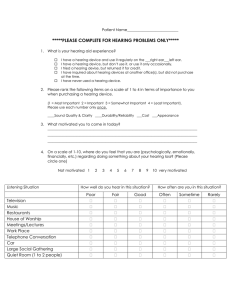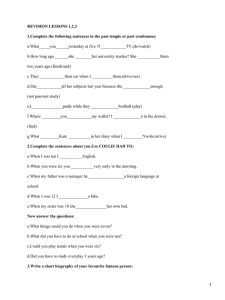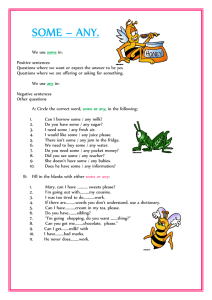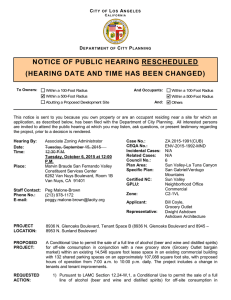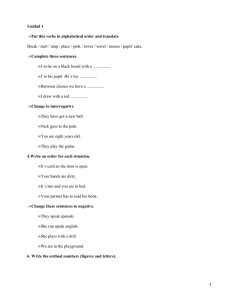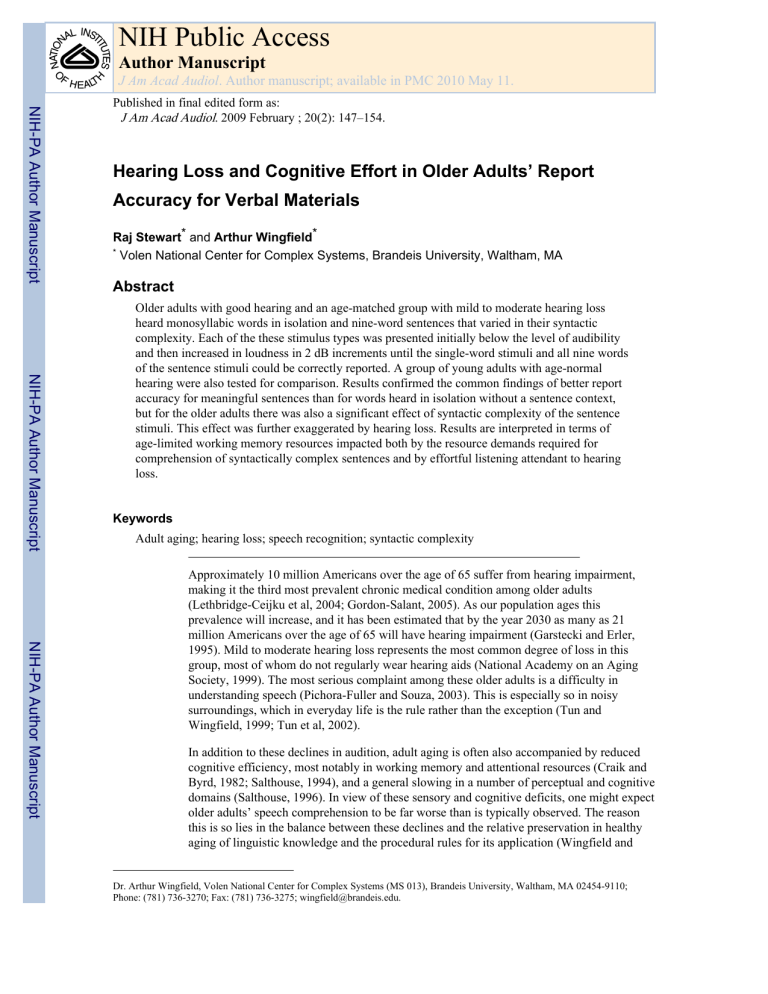
NIH Public Access Author Manuscript J Am Acad Audiol. Author manuscript; available in PMC 2010 May 11. NIH-PA Author Manuscript Published in final edited form as: J Am Acad Audiol. 2009 February ; 20(2): 147–154. Hearing Loss and Cognitive Effort in Older Adults’ Report Accuracy for Verbal Materials Raj Stewart* and Arthur Wingfield* Volen National Center for Complex Systems, Brandeis University, Waltham, MA * Abstract NIH-PA Author Manuscript Older adults with good hearing and an age-matched group with mild to moderate hearing loss heard monosyllabic words in isolation and nine-word sentences that varied in their syntactic complexity. Each of the these stimulus types was presented initially below the level of audibility and then increased in loudness in 2 dB increments until the single-word stimuli and all nine words of the sentence stimuli could be correctly reported. A group of young adults with age-normal hearing were also tested for comparison. Results confirmed the common findings of better report accuracy for meaningful sentences than for words heard in isolation without a sentence context, but for the older adults there was also a significant effect of syntactic complexity of the sentence stimuli. This effect was further exaggerated by hearing loss. Results are interpreted in terms of age-limited working memory resources impacted both by the resource demands required for comprehension of syntactically complex sentences and by effortful listening attendant to hearing loss. Keywords Adult aging; hearing loss; speech recognition; syntactic complexity NIH-PA Author Manuscript Approximately 10 million Americans over the age of 65 suffer from hearing impairment, making it the third most prevalent chronic medical condition among older adults (Lethbridge-Ceijku et al, 2004; Gordon-Salant, 2005). As our population ages this prevalence will increase, and it has been estimated that by the year 2030 as many as 21 million Americans over the age of 65 will have hearing impairment (Garstecki and Erler, 1995). Mild to moderate hearing loss represents the most common degree of loss in this group, most of whom do not regularly wear hearing aids (National Academy on an Aging Society, 1999). The most serious complaint among these older adults is a difficulty in understanding speech (Pichora-Fuller and Souza, 2003). This is especially so in noisy surroundings, which in everyday life is the rule rather than the exception (Tun and Wingfield, 1999; Tun et al, 2002). In addition to these declines in audition, adult aging is often also accompanied by reduced cognitive efficiency, most notably in working memory and attentional resources (Craik and Byrd, 1982; Salthouse, 1994), and a general slowing in a number of perceptual and cognitive domains (Salthouse, 1996). In view of these sensory and cognitive deficits, one might expect older adults’ speech comprehension to be far worse than is typically observed. The reason this is so lies in the balance between these declines and the relative preservation in healthy aging of linguistic knowledge and the procedural rules for its application (Wingfield and Dr. Arthur Wingfield, Volen National Center for Complex Systems (MS 013), Brandeis University, Waltham, MA 02454-9110; Phone: (781) 736-3270; Fax: (781) 736-3275; [email protected]. Stewart and Wingfield Page 2 NIH-PA Author Manuscript Stine-Morrow, 2000). This preservation makes possible older adults’ effective use of linguistic context to aid word recognition and sentence comprehension (Cohen and Faulkner, 1983; Wingfield et al, 1991; Pichora-Fuller et al, 1995). The recognition superiority for words heard within a meaningful sentence relative to words heard in isolation is well known (Black, 1952; Pollack and Pickett, 1963). This longstanding observation reflects the general principle that the amount of sensory information needed for correct recognition of any stimulus will be inversely proportional to its probability within a constraining context (Morton, 1969). Although especially important for older adults with reduced hearing acuity, this principle holds no less for young adults with good hearing. This latter point can be seen in performance/sound level functions for young adults with normal hearing tested for recognition of single words, such as Northwestern University Auditory Test No. 6 (NU-6) monosyllabic words (Tillman and Carhart, 1966) versus short five- to eight-word sentences (e.g., Davis and Silverman, 1978). Both types of stimuli are typically presented as open-response tests, scored in terms of the lowest level that yields a set percentage of words that can be reported correctly. Such comparisons invariably favor sentences over isolated words due to the structure provided by meaningful sentences (Brandy, 2002, p. 103). NIH-PA Author Manuscript This generality, although correct, overlooks the potential importance of the cognitive effort required for the comprehension of speech that is syntactically complex (Carpenter et al, 1994). This is important for word recognition because understanding the meaning of a sentence is the force that constrains the probability of a particular word in that context. Because comprehension of syntactically complex speech may draw on working memory resources that are already limited in normal aging (Salthouse, 1994), one would expect to see differential effects of syntactic complexity on older adults’ comprehension relative to that of younger adults, a common finding in the aging literature (Norman et al, 1991; Carpenter et al, 1994). When older adults’ already limited working memory resources are further strained by perceptual effort attendant to even a mild hearing loss, the negative effects on sentence comprehension of age and syntactic complexity can be further multiplied (Wingfield et al, 2006). NIH-PA Author Manuscript In the present experiment we examined intelligibility/sound level functions for three types of speech materials, comparing psychophysical functions for older adults with relatively good hearing and for an age-matched group with mild to moderate hearing loss. The stimuli of primary interest were sentences with equivalent word lengths, recorded by the same speaker, but that represented two degrees of syntactic complexity. Following the procedures outlined by Brandy (2002, p. 103), a sentence was presented initially at a level below audibility and then, in a series of presentations, progressively increased in sound level until all of the words of that sentence could be correctly reported. A similar procedure was also followed for monosyllabic words presented in isolation. These latter stimuli were taken from the NU-6 words (Tillman and Carhart, 1966) rerecorded by the same speaker as used for the sentence stimuli. For purposes of comparison, a group of young adults with good hearing was also tested. The purpose of this latter group was to reveal an ideal performance baseline for these materials. This experiment was intended to test three hypotheses. First, to the extent that age-related cognitive resources constrain comprehension of syntactically complex sentences (e.g., Carpenter et al, 1994; Wing-field et al, 2006), one would expect syntactic complexity to show a greater detrimental effect on older adults’ performance relative to that of younger adults. In this case this would be shown by the minimum sound level necessary to report correctly all of the words of a stimulus sentence. J Am Acad Audiol. Author manuscript; available in PMC 2010 May 11. Stewart and Wingfield Page 3 NIH-PA Author Manuscript The second hypothesis goes beyond the obvious expectation that those with reduced hearing acuity will require an increased sound level for the words of any sentence to be reported correctly. Rather, this hypothesis is based on the argument that when word recognition succeeds in the presence of a hearing loss, it may come at the cost of cognitive resources that might otherwise be available for postperceptual operations (Rabbitt, 1991; PichoraFuller, 2003; McCoy et al, 2005; Wingfield et al, 2005). This argument would lead to the additional prediction that the difference between syntactically simpler and syntactically more complex sentences would be larger at any given sound level for older adults with poorer hearing relative to those with better hearing. Finally, based on prior literature, one would expect that the sound level necessary for accurate report of the words of a meaningful sentence will, on average, be lower than that necessary for correct report of single words heard in isolation (see Brandy, 2002, for a review). However, to the extent that older adults with poorer hearing gain special benefit from linguistic support, the performance difference between single words and sentences of either type should be larger for older adults with poor hearing as compared to those with better hearing. METHOD Participants NIH-PA Author Manuscript Forty-eight participants took part in this study, 16 young adults and 32 older adults. All participants were native speakers of American English, and all reported themselves to be in good health, with no known history of stroke, Parkinson’s disease, or other neuropathology that might compromise their ability to carry out the study tasks. Audiometric assessment was conducted on all participants. Following otoscopic inspection, tympanometry was carried out using the GSI 38 Auto Tymp (Grason-Stadler, Inc., Madison, WI) to document middle ear integrity and to help rule out conductive hearing loss. An audiologic evaluation for pure-tone thresholds was carried out with a GSI 61 Clinical Audiometer (Grason-Stadler, Inc., Madison, WI) using standard audiometric techniques in a sound-attenuated testing room. NIH-PA Author Manuscript Young Adults with Normal Hearing—The younger group was composed of 16 undergraduates and graduate students, seven males and nine females, who ranged in age from 18 to 23 years (M = 19.2 years, SD = 2.9). These young participants had a mean of 13.7 years of education (SD = 2.1) at time of testing. The group had a mean pure-tone threshold average (PTA; averaged across 500, 1000, and 2000 Hz) of 5.3 dB HL in the better ear (SD = 4.2 [American National Standards Institute, 2004]). Older Adults with Better Hearing—This group consisted of 16 older adults, seven men and nine women, ranging in age from 65 to 73 years (M = 69.6, SD = 4.3). This group was also well educated, with a mean of 15.2 years of formal education (SD = 2.0). This average difference of 1.5 years of education was not significantly different from the young group (t[30] = 1.88, n.s.). The better-hearing older groups’ mean PTA (500, 1000500, 2000 Hz) for the better ear was 14.3 dB HL (SD = 6.7). Although this difference between the young adults and the older better-hearing group was significant (t[30] = 4.55, p < .001), both groups fell within the range typically defined as clinically normal hearing for speech (PTA < 25 dB HL [Hall and Mueller, 1997]). It should be noted, however, that as is typical for older adults (Morrell et al, 1996), the older adults’ thresholds were elevated at the higher frequencies beyond the traditional PTA. J Am Acad Audiol. Author manuscript; available in PMC 2010 May 11. Stewart and Wingfield Page 4 NIH-PA Author Manuscript Older Adults with Poorer Hearing—This group consisted of 16 participants, five men and 11 women, ranging in age from 65 to 76 years (M = 71.3, SD = 5.8), with a mean of 15.8 years of formal education (SD = 2.4). This group was thus closely matched with the first older group in terms of age (t[30] = .94, n.s.) and years of formal education (t[30] = .57, n.s.). The groups’ mean PTA (500, 1000500, 2000 Hz) for the better ear was 31.6 dB HL (SD = 9.4), which, as intended, was significantly different from that of the age-matched older adult group with better hearing (t[30] = 5.99, p < .001). Cognitive Matching—In order to ensure that there were no significant differences in cognitive ability between the two groups of older adults, all participants were tested on (a) forward and backward digit span (Wechsler, 1997) to assess short-term and working memory, (b) digit symbol substitution (Wechsler, 1997) as a test of psychomotor speed, and (c) Trail Making Test Parts A and B (Reitan, 1992) as a test of executive control (Lezak, 1995). Participants were also tested with the Shipley vocabulary test (Zachary, 1991) to ensure that all three groups were approximately equated for verbal ability. NIH-PA Author Manuscript The scores for each of the three participant groups are summarized in Table 1, where it can be seen that the two older adult groups were closely matched. There were no significant differences between the older groups with better and poorer hearing on forward digit span (t[30] = 0.42, n.s.), backward digit span (t[30] = 1.03, n.s.), digit symbol substitution (t[30] = 1.16, n.s.), Trails A (t[30] = 1.52, n.s.), Trails B (t[30] = 1.31, n.s.), or the Shipley vocabulary test (t[30] = 1.43, n.s.). These data give us confidence that experimental differences between the two older adult groups would not be due to differences in basic processes of memory, processing speed, executive function, or vocabulary knowledge. As would be expected, the young adults showed superior scores relative to the two older groups on all of the cognitive performance measures (p < .05 to < .001). As is common in healthy aging (Nicholas et al, 1997; Verhaeghen, 2003), the two older participant groups had slightly better vocabulary scores than the younger group, although this difference was small and did not reach significance. Stimuli Three classes of stimuli were employed in this study: single words and two types of short, nine-word sentences that differed in syntactic complexity. All stimuli were recorded by the same female speaker of American English. The single words and sentences were recorded with normal intonation; the sentences were recorded at a comfortable speaking rate of 145 words per minute. NIH-PA Author Manuscript Monosyllabic Words—Twenty common, phonemically balanced monosyllabic words were taken from the NU-6 wordlist (Till-man and Carhart, 1966) and recorded by the same speaker as would be recording the sentence stimuli. All recordings were conducted in a sound-attenuated testing room using an unidirectional Sony microphone routed directly to an iMac computer running SoundEdit software (Marcomedia, Inc., San Francisco). All stimuli were stored as uncompressed digital files and equated for root mean square amplitude. Sentence Stimuli and Syntactic Complexity—Syntactic complexity was manipulated by constructing two types of sentence structures that are known to differ in processing burden: sentences with subject-relative and with object-relative center-embedded clause structures (Just et al, 1996). An example of a subject-relative clause sentence might be “The author who insulted the critic hired a lawyer.” There are two important thematic roles represented in this sentence: the author, who is the agent who performs both actions (insulting and hiring), and the lawyer, who was hired. Although this is the simpler of the two J Am Acad Audiol. Author manuscript; available in PMC 2010 May 11. Stewart and Wingfield Page 5 NIH-PA Author Manuscript syntactic forms we contrasted, comprehension requires the listener to understand that The author hired a lawyer is the main clause of the sentence, interrupted by the relative clause who insulted the critic. NIH-PA Author Manuscript The second type of sentences we employed had the same words as in the subject-relative sentences but with the meaning expressed using an object-relative center-embedded clause structure: “The author who the critic insulted hired a lawyer.” In this type of structure not only does the embedded clause interrupt the main clause but the head noun phrase (the author) functions as both the subject of the main clause (hiring the lawyer) and the object of the relative clause (being insulted). Because the thematic roles in object-relative sentences are noncanonical and require extensive thematic integration (Gibson, 1998; Warren and Gibson, 2002), they are more difficult to process, and hence give the listener a greater cognitive burden, than subject-relative sentences. For these reasons, comprehension of an object-relative sentence is more resource demanding than processing a subject-relative sentence (Carpenter et al, 1994), such that sentences of this type take longer to process (Wingfield et al, 2003) and produce more comprehension errors (Carpenter et al, 1994) than their subject-relative counterparts. This extra processing burden is also revealed in functional neuroimaging studies, where one observes broader patterns of neural activity when comprehending object-relative sentences, compared with activity patterns for subjectrelative sentences (Just et al, 1996; Peelle et al, 2004) and especially so for older adults (Wingfield and Grossman, 2006). Twelve subject-relative clause sentences were constructed based on sentences used by Fallon et al (2006). All sentences were nine words in length, with different agents, actions, receivers, and outcomes for each of the sentences. From each of these subject-relative core sentences, an additional 12 sentences were constructed using the same words but with the meaning expressed with an object-relative clause structure. The 24 stimulus sentences along with the 20 NU-6 monosyllabic words were recorded on computer sound files for presentation using PsyScope scripting software (Cohen et al, 1993). NIH-PA Author Manuscript Procedures—All testing was conducted in a sound-attenuated testing room, with experimental stimuli presented binaurally using Eartone 3A insert earphones (E-A-R Auditory Systems, Aero Company, Indianapolis) routed from a GSI-61 audiometer. Half of the participants heard the monosyllabic words first, followed by the nine-word sentences, and half heard the word and sentence blocks in reverse order. In the single-word condition participants heard all 20 monosyllabic words with the order of the words varied between participants. For the sentence condition participants heard 12 sentences, six subject relative and six object relative, with a particular core sentence heard only once by a particular participant. The core sentences heard in their subject-relative or object-relative versions were counterbalanced across participants, such that, by the end of the experiment, each core sentence had been heard an equal number of times in each of its two forms. Order of presentation of the sentences was varied between participants, with subject-relative and object-relative sentences randomly intermixed. For the single-word stimuli, participants were told that a particular word would be presented at an initial sound level that would be too soft to hear and that the same word would be presented at louder and louder levels until the participant was able to recognize it correctly. Participants were told that they should attempt to give the correct word on each presentation, even if unsure. It was emphasized that their task was to attempt to recognize each word at the softest level possible. Each word was presented initially at −6 dB HL and then increased in 2 dB steps until it was correctly recognized. J Am Acad Audiol. Author manuscript; available in PMC 2010 May 11. Stewart and Wingfield Page 6 NIH-PA Author Manuscript The procedures for the sentences were the same, with each sentence presented first at −6 dB HL and then increased in amplitude in 2 dB steps until all nine words of each sentence were correctly reported. Instructions were again to attempt a response on each presentation even if unsure, with the goal being to report the full sentence correctly at the lowest level possible. RESULTS NIH-PA Author Manuscript Figure 1 shows the cumulative percentage of stimuli correctly reported as a function of increasing amplitude in 2 dB increments for the young adults (top panel), the older adults with better hearing (middle panel), and the older adults with poorer hearing (bottom panel) for each of the three stimulus types. These performance-amplitude curves for the monosyllable words, subject-relative sentences, and object-relative sentences all show similar S-shaped psychophysical functions although reaching the 50 percent correct threshold (indicated by the horizontal dotted lines) at different points. This was confirmed by a 3 (Group: young, older with better hearing, older with poorer hearing) × 3 (Stimulus type: single words, subject-relative sentences, object-relative sentences) mixed-design analysis of variance, with stimulus type as a within-participants variable. This analysis yielded a significant main effect of participant group (F[2, 135] = 75.77, p < .001) and a main effect of stimulus type (F[2, 135] = 22.55, p < .001), with these main effects moderated by a significant Group × Stimulus type interaction (F[4, 135] = 3.05, p < .025). The meaning of this interaction was revealed by a series of contrast score analyses. Comparing the top and middle panels shows that the small differences between the three types of materials (subject-relative sentences, object-relative sentences, and single-word stimuli) for the young adults with normal hearing become exaggerated by larger differences for the older adult group with better hearing. This was verified by conducting a contrast analysis on the difference scores at the 50 percent accuracy level between the subjectrelative and object-relative sentences for the young adults versus the analogous difference for the older adults with better hearing. As implied by visual inspection of these relevant curves in Figure 1, the contrast was significant (F[2, 45] = 83.23, p < .001). The contrast analysis for these two participant groups for the object-relative sentences versus the singleword stimuli was also significant (F[2, 45] = 1732.64, p < .001). An additional set of contrast analyses comparing the two older adult groups in the middle and bottom panels confirmed the impression that hearing loss further increased the degree of separation between the subject-relative and object-relative sentences (F[2, 45] = 562.37, p < .001), as well as between the object-relative sentences and the single-word stimuli (F[2, 45] = 994.21, p < .001). NIH-PA Author Manuscript DISCUSSION Since the pioneering work of Welford (1958), the cognitive aging literature has been consistent in representing mental performance in adult aging as a balance between declines in basic processes such as memory, attention, and processing speed versus the maintenance of skills and knowledge acquired through a lifetime of experience. There is certainly ample evidence for age-related declines in working memory (Salthouse, 1994) and attentional resources (Craik and Byrd, 1982), reduced efficiency in inhibiting potential sources of interference (Stoltzfus et al, 1996), and a general slowing in many perceptual and cognitive operations (Salthouse, 1996). To these changes must also be added the increased incidence of hearing loss among older adults, which, although subject to wide interindividual variability, tends to increase in incidence and degree in advancing years (Morrell et al, 1996). J Am Acad Audiol. Author manuscript; available in PMC 2010 May 11. Stewart and Wingfield Page 7 NIH-PA Author Manuscript On the positive side, the results of the present experiment confirm the advantage that older adults can take from linguistic support. This was evidenced by the larger difference at a given sound level between the ability to recognize words heard in the absence of a sentential context and words heard as part of a meaningful sentence. This meaningful speech effect is well known in audiology and illustrates the interaction in speech recognition between sensory input and the availability of top-down knowledge as may be available from linguistic or extralinguistic context (Pichora-Fuller, 2003; Wingfield et al, 2006). It is noteworthy in this regard that the size of this word-versus-sentence difference increased progressively with age and hearing acuity, from the young adults with normal hearing, through the older adults with better hearing, to the older group with mild to moderate hearing loss, who demonstrated the largest difference. We take this progression to reflect an adaptive response to declining sensory clarity, whether at the conscious or automatic level. NIH-PA Author Manuscript Although linguistic knowledge and its use in speech recognition tend to be preserved in healthy aging, the present results illustrate one of the limiting factors in older adults’ comprehension of speech. This is the effect of syntactic complexity that places older adults at a greater disadvantage than their young adult counterparts. The source of this difficulty lies in the special demands on working memory resources required for the comprehension of sentences with complex syntax as previously described. When hearing an object-relative clause sentence such as “The author who the critic insulted hired the lawyer,” it is still possible in this example to determine who hired the lawyer, but it requires more extensive thematic integration within working memory than for simpler subject-relative sentences (Carpenter et al, 1994; Warren and Gibson, 2002). It is presumed to be for these reasons, and their concomitant effects of word predictability, that for a given sound level, more words can be reported correctly from subject-relative clause sentences than object-relative clause sentences. This was seen to be so, moreover, even though the two sentence types had the same sentence lengths, were spoken by the same speaker at the same speech rate, and contained exactly the same words, albeit in a different word order. NIH-PA Author Manuscript To the extent that older adults begin with more limited working memory resources than young adults (Salthouse, 1994), this extra demand would have a differentially greater impact on older adults’ available resources. An added factor might be claims for older adults’ reduced efficiency in inhibition (Stoltzfus et al, 1996), which could interact in a negative way with the noncanonical word order of object-relative sentences. The performance difference between the young participants and the older adults with better hearing may have been a compound of these cognitive difference factors but also a potential contribution of the small but significant acuity difference between the young adults and this better-hearing older group. For the comparison between the two older groups, which is our primary interest, however, the two groups were matched for age and cognitive function, differing only in hearing acuity. We suggest that the exaggeration of the syntactic effects by hearing loss can most directly be accounted for by the already age-limited working memory being drawn upon by the additional resources necessary to comprehend sentences with more complex syntax and the added resource allocation associated with effortful listening. For the better-hearing older adults in this experiment, simplifying the syntax from an object-relative to a subject-relative structure was equivalent to increasing the sound level by an average of 4.8 dB. For the older adults with mild to moderate hearing loss it was equivalent to a 7.8 dB increase in sound level. There are many reasons why only 40 to 60 percent of older adult hearing aid users express satisfaction with their use (Humes, 2001) and only a minority of hearing-impaired older adults use hearing aids on a regular basis (Popelka et al, 1998). High on this list is older J Am Acad Audiol. Author manuscript; available in PMC 2010 May 11. Stewart and Wingfield Page 8 NIH-PA Author Manuscript adults’ special susceptibility to background noise and distraction from competing speech (Tun and Wingfield, 1999; Tun et al, 2002) and the rapidity of natural speech in the face of a generally slowed perceptual and cognitive system (Gordon-Salant and Fitzgibbons, 1997; Wingfield et al, 1999). The present results add to this list the processing challenge imposed by syntactically complex speech, with this cognitive challenge compounded by the draw on resources of effortful listening attendant to even a mild hearing loss. Although this age-related processing difficulty may not directly be aided by amplification, these present results suggest that indirect effects might nevertheless operate. That is, to the extent that increasing the sound level of the speech input reduces effortful listening, with a resultant reduction in necessary demands on limited processing resources, the sentence complexity factor may be mitigated at least in part by effective amplification. There is, of course, the caveat that central auditory processing deficits can also be encountered in adult aging, with negative effects on speech intelligibility beyond the peripheral loss (Chisolm et al, 2003). In either case, these present results suggest an added source of the often-heard complaint of those with hearing loss of fatigue associated with continual perceptual effort (Kramer et al, 1997). As illustrated here, perceptual effort can have an effect on cognitive resources with concomitant effects on performance success. That the effects are often subtle makes them no less important. NIH-PA Author Manuscript Acknowledgments This work was supported by National Institutes of Health Grant AG019714 from the National Institute on Aging. We gratefully acknowledge support from the WM Keck Foundation. Abbreviations PTA pure-tone threshold average for hearing levels at 500, 1000, and 2000 Hz References NIH-PA Author Manuscript American National Standards Institute. Specification for Audiometers (ANSI S3.6-2004) (Revision of ANSI S3.6-1996). New York: Author; 2004. Black JW. Accompaniments of word intelligibility. J Speech Disord 1952;17:409–418. Brandy, WT. Speech audiometry. In: Katz, J., editor. Handbook of Clinical Audiology. 5. Philadelphia: Lippincott Williams Wilkins; 2002. p. 96-110. Carpenter, PA.; Miyaki, A.; Just, MA. Working memory constraints in comprehension: evidence from individual differences, aphasia, and aging. In: Gernsbacher, M., editor. Handbook of Psycholinguistics. San Diego: Academic Press; 1994. p. 1075-1122. Chisolm TH, Willott JF, Lister JL. The aging auditory system: anatomic and physiologic changes and implications for rehabilitation. Int J Audiol 2003;42:2S3–2S10. [PubMed: 12918622] Cohen G, Faulkner S. Word recognition: age differences in contextual facilitation effects. Br J Psychol 1983;74:239–251. Cohen JD, MacWhinney B, Flatt M, Provost J. PsyScope: an interactive graphic system for designing and controlling experiments in the psychology laboratory using Macintosh computers. Behav Res Methods 1993;25:257–271. Craik, FIM.; Byrd, M. Aging and cognitive deficits: the role of attentional resources. In: Craik, FIM.; Trehub, S., editors. Aging and Cognitive Processes. New York: Plenum; 1982. p. 191-211. Davis, H.; Silverman, SR. Hearing and Deafness. New York: Holt Rinehart Winston; 1978. Rev. edition Fallon M, Peelle JE, Wingfield A. Spoken sentence processing in young and older adults modulated by task demands: evidence from self-paced listening. J Gerontol Psychol Sci 2006;61B:P10–P17. J Am Acad Audiol. Author manuscript; available in PMC 2010 May 11. Stewart and Wingfield Page 9 NIH-PA Author Manuscript NIH-PA Author Manuscript NIH-PA Author Manuscript Garstecki D, Erler S. Older women and hearing. Am J Audiol 1995;4:41–46. Gibson E. Linguistic complexity: locality of syntactic dependencies. Cognition 1998;68:1–76. [PubMed: 9775516] Gordon-Salant S. Hearing loss and aging: new research findings and clinical implications. J Rehab Res Dev 2005;42:9–24. Gordon-Salant S, Fitzgibbons PJ. Selected cognitive factors and speech recognition performance among young and elderly listeners. J Speech Lang Hear Res 1997;40:423–431. [PubMed: 9130210] Hall, J.; Mueller, G. Audiologist Desk Reference. San Diego: Singular Publishing; 1997. Humes LE. Issues in evaluating the effectiveness of hearing aids in the elderly: what to measure and when. Semin Hear 2001;22:303–315. Just MA, Carpenter PA, Keller TA, Eddy WF, Thulborn KR. Brain activation modulated by sentence comprehension. Science 1996;274:114–116. [PubMed: 8810246] Kramer SE, Kapteyn TS, Kuik DJ. Assessing aspects of auditory handicap by means of pupil dilation. Audiology 1997;36:155–164. [PubMed: 9193733] Lethbridge-Ceijku M, Schiller JS, Bernadel L. Summary health statistics for U.S. adults: National Health Interview Survey. Vital Health Stat 2004;10:1–151. Lezak, MD. Neuropsychological Assessment. 3. New York: Oxford University Press; 1995. McCoy SL, Tun PA, Cox LC, Colangelo M, Stewart RA, Wingfield A. Hearing loss and perceptual effort: downstream effects on older adults’ memory for speech. Q J Exp Psychol 2005;58A:22–33. Morrell CH, Gordon-Salant S, Pearson JD, Brant LJ, Fozard JL. Age- and gender-specific reference ranges for hearing level and longitudinal changes in hearing level. J Acoust Soc Am 1996;100:1949–1967. [PubMed: 8865630] Morton J. Interaction of information in word recognition. Psychol Rev 1969;76:165–178. National Academy on an Aging Society. Hearing Loss: A Growing Problem that Affects Quality of Life. 2. Washington, DC: Author; 1999. Nicholas, M.; Barth, C.; Obler, LK.; Au, R.; Albert, ML. Naming in normal aging and dementia of the Alzheimer’s type. In: Goodglass, H.; Wingfield, A., editors. Anomia: Neuroanatomical and Cognitive Correlates. San Diego: Academic Press; 1997. p. 166-188. Norman S, Kemper S, Kynette D, Cheung H, Anagnopoulos C. Syntactic complexity and adults’ running memory span. J Gerontol Psychol Sci 1991;46:346–351. Peelle E, McMillan C, Moore P, Grossman M, Wingfield A. Dissociable patterns of brain activity during comprehension of rapid and syntactically complex speech: evidence from fMRI. Brain Lang 2004;91:315–325. [PubMed: 15533557] Perry AR, Wingfield A. Contextual encoding by young and elderly adults as revealed by cued and free recall. Aging Cogn 1994;1:120–139. Pichora-Fuller AMK. Cognitive aging and auditory information processing. Int J Audiol 2003;42:2S26–2S32. [PubMed: 12918626] Pichora-Fuller MK, Schneider BA, Daneman M. How young and old adults listen to and remember speech in noise. J Acoust Soc Am 1995;97:593–607. [PubMed: 7860836] Pichora-Fuller MK, Souza PE. Effects of aging on auditory processing of speech. Int J Audiol 2003;42:2S11–2S16. [PubMed: 12918623] Pollack I, Pickett JM. The intelligibility of excerpts from conversation. Lang Speech 1963;6:165–171. Popelka MM, Cruikshanks KJ, Wiley TL, Tweed TS, Klein BEK, Klein R. Low prevalence of hearing aid use among older adults with hearing loss: the epidemiology of hearing loss study. J Am Geriatr Soc 1998;46:1075–1078. [PubMed: 9736098] Rabbitt PMA. Mild hearing loss can cause apparent memory failures which increase with age and reduce with IQ. Acta Otolaryngol Suppl 1991;476:67–176. Reitan RM. Validity of the Trail Making Test as an indication of organic brain damage. Percept Mot Skills 1992;8:271–276. Salthouse TA. The aging of working memory. Neuropsychology 1994;8:535–543. Salthouse TA. The processing-speed theory of adult age differences in cognition. Psychol Rev 1996;103:403–428. [PubMed: 8759042] J Am Acad Audiol. Author manuscript; available in PMC 2010 May 11. Stewart and Wingfield Page 10 NIH-PA Author Manuscript NIH-PA Author Manuscript Stoltzfus, ER.; Hasher, L.; Zacks, RT. Working memory and aging: current status of the inhibitory view. In: Richardson, JR., editor. Working Memory and Cognition. New York: Oxford University Press; 1996. p. 66-88. Tillman, TW.; Carhart, R. An Expanded Test for Speech Discrimination Utilizing CNC Monosyllabic Words. San Antonio: U.S. Air Force School of Aerospace Medicine, Brooks Air Force Base; 1966. Northwestern University Auditory Test No. 6. Technical Report No. SAM-TR-66-55 Tun PA, O’Kane G, Wingfield A. Distraction by competing speech in young and older adult listeners. Psychol Aging 2002;17:453–467. [PubMed: 12243387] Tun PA, Wingfield A. One voice too many: adult age differences in language processing with different types of distracting sounds. J Gerontol Psychol Sci 1999;54B:P317–P327. Verhaeghen P. Aging and vocabulary score: a meta-analysis. Psychol Aging 2003;18:332–339. [PubMed: 12825780] Warren T, Gibson E. The influence of referential processing on sentence complexity. Cognition 2002;85:79–112. [PubMed: 12086714] Wechsler, D. Wechsler Adult Intelligence Scale. 3. New York: Psychological Corporation; 1997. Welford, AT. Ageing and Human Skill. London: Oxford University Press; 1958. Wingfield A, Aberdeen JS, Stine EAL. Word onset gating and linguistic context in spoken word recognition by young and elderly adults. J Gerontol Psychol Sci 1991;46:P127–P129. Wingfield A, Grossman M. Language and the aging brain: patterns of neural compensation revealed by functional brain imaging. J Neurophysiol 2006;96:2830–2839. [PubMed: 17110737] Wingfield A, McCoy SL, Peelle JE, Tun PA, Cox LC. Effects of adult aging and hearing loss on comprehension of rapid speech varying in syntactic complexity. J Am Acad Audiol 2006;17:487– 497. [PubMed: 16927513] Wingfield A, Peelle JE, Grossman M. Speech rate and syntactic complexity as multiplicative factors in speech comprehension by young and older adults. Neuropsychol Dev Cogn B Aging Neuropsychol Cogn 2003;10:310–322. Wingfield, A.; Stine-Morrow, EAL. Language and speech. In: Craik, FIM.; Salthouse, TA., editors. Handbook of Aging and Cognition. 2. Mahwah, NJ: Erlbaum; 2000. p. 359-416. Wingfield A, Tun PA, Koh CK, Rosen MJ. Regaining lost time: adult aging and the effect of time restoration on recall of time-compressed speech. Psychol Aging 1999;14:380–389. [PubMed: 10509694] Wingfield A, Tun PA, McCoy SL. Hearing loss in older adulthood: what it is and how it interacts with cognitive performance. Curr Dir Psychol Sci 2005;14:144–148. Wingfield A, Tun PA, McCoy SL, Stewart RA, Cox LC. Sensory and cognitive constraints in comprehension of spoken language in adult aging. Semin Hear 2006;27:273–283. Zachary, RA. Revised Manual. Los Angeles: Western Psychological Services; 1991. Shipley Institute of Living Scale. NIH-PA Author Manuscript J Am Acad Audiol. Author manuscript; available in PMC 2010 May 11. Stewart and Wingfield Page 11 NIH-PA Author Manuscript NIH-PA Author Manuscript NIH-PA Author Manuscript Figure 1. Cumulative percentage of words correctly reported for single-word stimuli and for sentences with subject-relative and object-relative clause syntactic structures as a function of sound level increased in 2 dB increments. Data are shown for young adults with normal hearing (top panel), older adults with better hearing (middle panel), and older adults with mild to moderate hearing loss (bottom panel). The horizontal dotted line in each panel shows the point at which 50% of the words in each of the three conditions were reported correctly. J Am Acad Audiol. Author manuscript; available in PMC 2010 May 11. NIH-PA Author Manuscript 5.3 Digit Symbol Substitution 19.2 34.9 Trails A Trails B Executive Control 71.9 6.1 Backward Digit Span Speed 6.8 Forward Digit Span Memory 15.5 13.7 Education (years) Pure-Tone Threshold Average (dB HL) 19.2 Age (years) Vocabulary Mean Variable (5.8) (3.3) (7.6) (1.2) (1.1) (4.2) (1.6) (2.1) (2.9) (SD) Younger Adults 68.5 34.6 57.1 4.5 5.4 14.3 16.3 15.2 69.6 Mean (11.9) (8.7) (8.6) (1.0) (1.3) (6.7) (1.8) (2.0) (4.3) (SD) Better Hearing 79.2 36.8 58.1 4.6 5.7 31.6 16.7 15.8 71.3 Mean (14.2) (7.7) (9.7) (1.3) (1.4) (9.4) (1.8) (2.4) (5.8) (SD) Poorer Hearing Older Adults NIH-PA Author Manuscript Characteristics of Three Participant Groups NIH-PA Author Manuscript Table 1 Stewart and Wingfield Page 12 J Am Acad Audiol. Author manuscript; available in PMC 2010 May 11.

